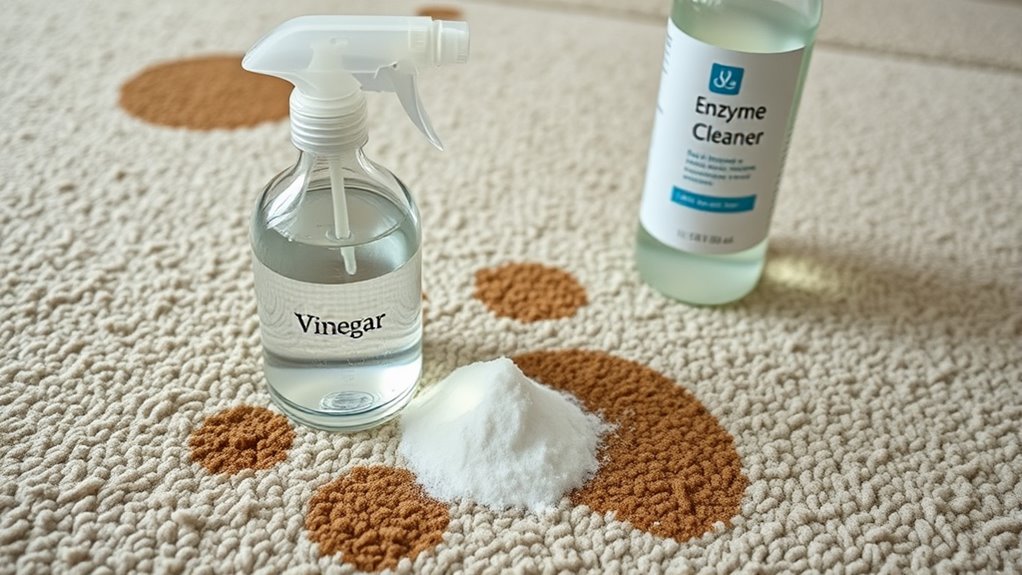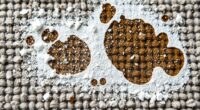When cleaning pet urine, act quickly to prevent stains and odors from settling. Start by spraying a vinegar solution—equal parts white vinegar and water—onto the affected area to neutralize ammonia. Let it sit, then blot and sprinkle baking soda to absorb lingering smells. For stubborn stains, enzyme cleaners work best by breaking down proteins and uric acid; follow instructions carefully. Allow everything to dry thoroughly to restore freshness. Stay with us to discover more effective tips.
Key Takeaways
- Act quickly by blotting excess urine to prevent stains and odors from setting.
- Use a vinegar-water solution to neutralize ammonia and break down urine components.
- Sprinkle baking soda after cleaning to absorb lingering odors and lift remaining stains.
- Apply enzyme cleaners to effectively break down proteins and uric acid, eliminating stains and smells.
- Ensure thorough drying post-treatment to prevent residual odors and restore cleanliness.

Pet urine stains can be stubborn and challenging to remove, but acting quickly makes all the difference. When it comes to stain removal and eliminating household odor, your immediate response is key. The sooner you address the accident, the easier it will be to neutralize the smell and lift the stain from your carpet or upholstery. Start by blotting the area with paper towels or a clean cloth to soak up as much urine as possible. Avoid rubbing, as that can spread the stain further and embed it deeper into the fibers. Once you’ve soaked up the excess liquid, it’s time to treat the spot with effective cleaning solutions.
A vinegar solution is a versatile and natural way to combat pet urine. Mix equal parts white vinegar and water in a spray bottle, and generously spray the affected area. Vinegar’s acidity helps neutralize the ammonia in urine, which is responsible for the strong household odor. Let it sit for 5-10 minutes, then blot the area again with a clean cloth. Repeat this process if needed, and follow up with a clean, damp cloth to remove any residual vinegar. Afterward, sprinkle baking soda over the damp area to absorb lingering smells. Allow the baking soda to sit for several hours, or preferably overnight, before vacuuming thoroughly. Baking soda not only neutralizes odors but also helps lift remaining stains from your carpet.
For more stubborn stains and odors, enzyme cleaners are your best bet. These products contain specific enzymes that break down the proteins and uric acid in pet urine, effectively eliminating both the stain and the odor at the source. Follow the instructions on the label carefully, applying enough enzyme cleaner to saturate the affected area. Cover it with plastic wrap or a damp cloth to prevent evaporation, and let it sit for the recommended time. Enzyme cleaners work best if they’re given time to digest the urine components, so patience is key. Once the treatment is complete, blot the area with a clean cloth and allow it to dry thoroughly. This approach guarantees that the stain is fully removed and the household odor is neutralized, leaving your space fresh and clean.
Frequently Asked Questions
How Long Does It Take for Vinegar to Neutralize Pet Urine Odors?
Vinegar usually takes about 5 to 10 minutes to neutralize pet urine odors effectively. During this neutralization time, the vinegar reacts with the ammonia in the urine, helping eliminate the odor. To guarantee thorough odor elimination, you should let the vinegar sit on the affected area for at least 10 minutes before blotting or rinsing. This process maximizes odor removal and keeps your space smelling fresh.
Can Baking Soda Be Used on All Types of Carpets?
Yes, you can use baking soda on most carpets, but consider carpet durability first. Baking soda is generally safe for many types, but avoid using it on delicate or wool carpets to prevent damage. Always test a small area first to guarantee baking soda safety. If your carpet is durable, sprinkle baking soda, let it sit, then vacuum thoroughly to neutralize odors and refresh your carpet without harm.
Are Enzyme Cleaners Safe for Pets and Children?
Enzyme cleaners are generally safe for pets and children when used properly, but always check enzyme safety labels for specific ingredients. You want to verify they’re non-toxic, hypoallergenic, and free of harmful chemicals that could jeopardize your pet’s health or your family’s well-being. Follow application instructions carefully, keep pets and kids away during and after use, and store enzyme cleaners securely to maintain safety and peace of mind.
How Often Should I Repeat Cleaning Treatments?
You should repeat cleaning treatments until the area is completely odor-free and visibly clean to guarantee effective treatment. Typically, cleaning frequency depends on the severity of the stain and odor, but most experts recommend re-treating every 24-48 hours if smell persists. This approach helps maintain treatment effectiveness and prevents pets from re-soiling the same spot. Regular monitoring ensures the area stays fresh and odorless over time.
Do Natural Remedies Work Better Than Commercial Products?
Natural remedies can be effective, but commercial products often provide more consistent and powerful results. While natural remedies like vinegar or baking soda are eco-friendly and safe, they may not eliminate all odors or stains completely. Commercial enzyme cleaners are specially formulated to break down pet urine proteins, making them more reliable. For tough spots, combining both approaches might give you the best results.
Conclusion
Cleaning pet urine is like tending to a garden—you need the right tools and patience to see it flourish again. Whether you choose vinegar, baking soda, or enzyme cleaners, each method acts as a gentle rain that washes away stains and odors. Stay consistent, and you’ll restore your home’s freshness. Remember, with a little effort, you can turn a messy patch into a clean, inviting space—your pet’s happy place and yours.









